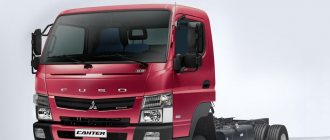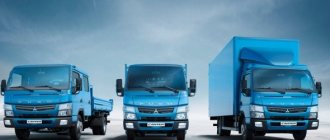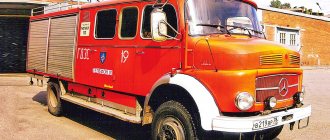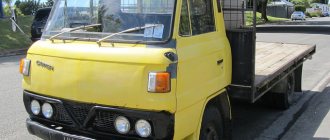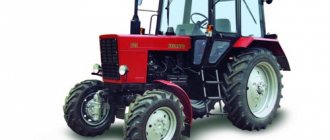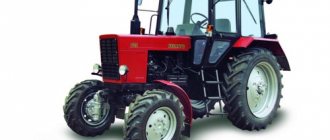In total, about three thousand Fuso Canter cars have been sold by dealers since the launch of the model in Naberezhnye Chelny (Tatarstan). In addition to a very reasonable price - about one and a half million rubles for a chassis with a manufactured goods van - the Japanese is also attracted by its reputation as a very reliable car. This has long been tested in practice - since the early 1990s, more than thirty thousand used right-hand drive cars of this model have been imported to Russia from Japan. And, as a rule, the owners who wrote reviews on the Internet are satisfied with the purchase. According to the analytical agency "Autostat" (see table), the majority of registered vehicles are 15-23 year old right-hand drive Mitsubishi Canters. Yes, that’s exactly what, in a nutshell, the car is called in the domestic market. The Japanese began to intensively promote the Fuso brand, known since 1932, only in 2007. Since then, apparently guided by the results of some very complex marketing research, the company has been promoting the same car either under the Mitsubishi Fuso brand - in Russia, Belarus, the Baltic countries, Turkey, USA, Canada, etc. - or simply Fuso , as in most countries of Europe, Mexico, Australia, etc. Silencing or advertising the generic name of a company is purely individual for the market of a particular country - for example, buyers from Slovakia are impressed by the fact that Canter is a Mitsubishi, and their Czech neighbors are impressed by some reasons it is not necessary to know this. Or even undesirable.
Content
- 1 Gasoline engines
- 2 Diesel engines 2.1 KE series
- 2.2 4DQx
- 2.3 4DRx
- 2.4 4D3x
- 2.5 4M4x
- 2.6 4M5x
- 2.7 4P1x
- 2.8 4V2x
- 3.1 KE series
- 4.1 8DCxx
- 5.1 10DCx
Price new and used
The cost of the new Mitsubishi Fuso Canter varies depending on the version:
- chassis – from 2.42 million rubles;
- onboard platform – from 2.55 million rubles;
- manufactured goods van – from 2.55 million rubles;
- isothermal van – from 2.60 million rubles;
- KMU – from 3.86 million rubles;
- dump truck - from 2.79 million rubles;
- portal loader – from 3.31 million rubles;
- auto hydraulic lift – from 4.35 million rubles.
Price tags for used versions from 2008-2010 range from 600-950 thousand rubles, from 2012-2014 – 1.2-1.6 million rubles.
Diesel engines
KE series
- KE31
2199 cc, bore and stroke 79.375 x 111.125 mm, peak power 61 hp. (45 kW) at 3600 rpm. Mainly suitable for Mitsubishi Jeep, this engine is rooted in JH4 design. The six-cylinder KE36 with 3.3 liters is based on the KE31.
4DQx
- 4DQ1
1986 cc, peak power 68 hp (50 kW). Fits the T720 Mitsubishi Canter from 1963 (as 4DQ11A) this engine was replaced by the 4DR1 in 1968.[1]
4DRx
- 4DR1
2384 cc, overhead camshaft, 2 valves per cylinder, cross flow cylinder head design. Peak power is 75 hp. (55 kW) at 3800 rpm. The cylinder diameter and piston stroke are 88 x 98 mm. Introduced in June 1968 for the Canter T90 series.[1] - 4DR5/6
2659 cc, Bore and stroke 92 x 100 mm.[2] The 4DR5 has indirect injection and a compression ratio of 20:1. Naturally aspirated, its peak power is 80 hp. (59 kW) at 3800 rpm with a maximum torque of 18 kgm at 2200 rpm. The 4DR6 is a direct injection turbocharged version with a compression ratio of 17.5:1 and a Mitsubishi TD04-1 turbocharger developing up to 100 hp. (74 kW) and 22.2 kgm of torque. Both of these engines were used in large forklifts and in Mitsubishi's J20 and J50 series Canter and Jeep models. The latest version of the 4DR5, installed on the J24A, was turbocharged and intercooled, producing 135 hp. - 4DR7
2835 cc, peak power 88 hp. (65 kW) [3] - according to some sources, this is 2.5 liters with a power of 70 hp. (51 kW)
4D3x
In 4D3x
is a series of 4-cylinder diesel engines with direct injection.
- 4D30
3298 cc, bore 100 mm, stroke 105 mm, naturally aspirated, 90–95 hp. (66–70 kW). European models stated 80 hp. (59 kW) DIN.[4] - 4D31
3298 cc, bore 100 mm, stroke 105 mm, turbocharged, 100–130 hp (74–96 kW)[5] - 4D32
3567 cc, bore 104 mm, stroke 105 mm, 110 hp. (81 kW) - 4D33
4214 cc, 108mm bore x 115mm stroke, naturally aspirated, gear driven camshaft, direct injection and in-line fuel pump.[6] In Canter trucks (general export model), this engine is standard and produces 83 kW (113 hp) at 3,200 rpm respectively. 304 Nm at 1600 rpm [7], but performance may vary slightly on other trucks/markets, for example due to 120–135 hp gross power being quoted. (88–99 kW). - 4D34
3907 cc, cylinder bore 104 mm, piston stroke 115 mm, turbocharged.
In 2022, 4D34 engines, for example in the Philippines, comply with the Euro 2 standard. In Europe they have been replaced by the introduction of Euro 5. Peak power is 120 hp. (88 kW).[3] The turbocharged T4
has 165 hp. (121 kW). Known versions:
4D34-2AT4
, 100 kW (136 hp) at 2900 rpm, 370 Nm at 1600 rpm [7], option on Canter 6.0 - 8.2 t (general export model)
4D34-2AT5
, 81 kW (110 hp) at 2900 rpm, 275 Nm at 1600 rpm [7], option on Canter 4.4 - 6.0 t (general export model)
4D34-2AT7
, 100 kW (136 hp) at 2900 rpm, 373 Nm at 1600 rpm [7], Canter 8.25 t (general export model Indonesia) 4D34-2AT8
,
92 kW (125 hp) at 2900 rpm, 324 Nm at 1600 rpm [7], Canter 7.5t (general Indonesia export model)
- 4D35
4.56 l, 140 hp (103 kW) - 4D36
3.56 l - 4D37
3907 cc, Common Rail, four valves per cylinder, gear driven camshaft[6]
- 100 kW at 2500 rpm, 420 Nm at 1500 rpm
- ~2020- Fuso FA/FI, Euro IV/V with SCR
- 125 kW at 2500 rpm, 520 Nm at 1500 rpm
4M4x
Main article: Mitsubishi 4M4 engine
- 4M40
- 2835 cu.m. Inline four cylinder, ohc, natural inhalation and swirl combustion. Introduced in the sixth generation Canter in September 1996, the engine produces 69 kW (94 hp) and 191 Nm at 2000 rpm. The fuel injection pump can be of the rotary type. Later engines complied with the Euro 2 standard. It replaced the 2.5-liter. 4D56 in the most passenger Canters. - 4M41
- this engine is 3200 cc. Four cylinders, vortex combustion engine and rotary fuel pump. They were Euro 2 compliant and were fitted to the Canter from 02/1999 to 09/2001, producing 85kW and 216Nm at 2000rpm. - 4M42-AOT
- 2977 cubic meters. Another 4 cylinders with DOHC, direct injection, Bosch VP44 rotary injection pump with electronic control, turbocharging and intercooling. Thanks to exhaust gas recirculation, they were Euro 3 compliant and were fitted to the Canter from 09/2001 with outputs of 92 kW at 3200 rpm and 294 Nm at 1800 rpm. From 10/2007, the engine was modified to common rail injection, VNT supercharging and a diesel particulate filter were added to comply with Euro 4 standard. On the Canter these were replaced by 4P10 in 07/2009.
4M5x
In 4M50
is a series of 4-cylinder diesel engines with a capacity of 4899 cc. cm, bore and stroke 114 x 120 mm, gear driven DOHC, 4 valves per cylinder and common rail direct injection with turbocharging and intercooler.[6]
- 4M50-T3 - 103 kW, 412 Nm
02/2004- Mitsubishi Fuso Canter
- 4M50-4AT4 – 110 kW at 2700 rpm, 441 Nm at 1600 rpm
- 4M50-T4 - 118 kW, 470 Nm
02/2004- Mitsubishi Fuso Canter
- 4M50-T5 or 4M50-5AT5 – 132 kW at 2700 rpm, 530 Nm at 1600 rpm
02/2004- Mitsubishi Fuso Canter Rose 10/2004-06/2008 Nissan Civil
B 4M51
is a 4-cylinder diesel engine with a capacity of 5249 cc. cm, 140–155 hp (103–114 kW).
4P1x
In 4H10
2998 cc turbodiesel engine
cm, purchased by Daimler from Iveco for Mitsubishi Fuso Canter from 2009/2010. Essentially, this is an Iveco F1C. The 4P10 engine with a common rail fuel system with high-pressure piezo injectors complies with Euro 6 emissions regulations with Bluetec selective catalytic reduction system and was introduced as the new "Global Powertrain" for Canter. Since the "General Export Models" remained with the old Mitsubishi engines, the use of the "Global Powertrain" was limited to highly developed countries with strict exhaust emission restrictions, such as Japan (only from the 8th generation Canter), Europe and North America. In 2022, a revised version with improved torque, fuel economy and exhaust emissions appeared for the Canter under the name 4P10+ in Japan. 4P10T2
- 130 hp.
(96 kW) at 3500 rpm, 300 Nm (221 lb-ft) at 1300 rpm in Europe, 4P10T4
- 150 hp
(110 kW) at 3500 rpm, 370 Nm (273 lb⋅ft) at 1320 rpm in Europe 4P10T5
- 161 hp.
(120 kW) at 3400 rpm, 489 Nm (361 lb-ft) at 1300 rpm, 2 turbochargers in NFTA 4P10T6
- 175 hp.
(129 kW) at 3500 rpm, 430 Nm (317 lb⋅ft) at 1600 rpm in Europe 4P10T1 +
- 110 hp.
(81 kW) at 2130 rpm, 430 Nm (317 lb⋅ft) Nm at 1600 rpm, in Japan for Canter 1.5 tons 4P10T2 +
- 130 hp.
(96 kW) at 2130 rpm, 430 Nm (317 lb⋅ft) Nm at 1600-2130 rpm, in Japan for Canter 4P10T4 +
- 150 hp.
(110 kW) at 2440 rpm, 430 Nm (317 lb⋅ft) Nm at 1600-2440 rpm, in Japan for Canter 4P10T6 +
- 175 hp.
(129 kW) at 2860 rpm, 430 N⋅m (317 lb⋅ft) N⋅m at 1600-2860 rpm, in Japan for Canter Applications
Mitsubishi Fuso Canter Mitsubishi Fuso Rose Nissan Civic Temsa Prestij Mitsubishi Jeep Line
4V2x
bore 104 x stroke 115 mm, 3907 cc, gear driven camshaft, based on 4D37 engine. with common rail direct injection, turbocharged[6]
- 4V20
125 kW at 2500, 520 Nm at 1500, with SCR and DPF
~2020- Fuso Fighter JDM
- 4V21
100 kW at 2500, 420 Nm at 1500, Euro IV
~2020- Gen8 based Fuso Canter export model
Specifications
Dimensions depending on version (E/G/H/J):
- length – 5975/6655/7130/7565 mm;
- width (for all versions) – 2135 mm;
- height (for all versions) – 2235 mm;
- wheelbase – 3410/3870/4170/4470 mm;
- front track (for all versions) – 1665 mm;
- rear track (for all versions) – 1660 mm;
- ground clearance (for all versions) – 200 mm;
- frame width (for all versions) – 840 mm;
- front overhang (for all versions) – 1145 mm;
- rear overhang – 1420/1640/1815/1950 mm;
- minimum turning radius – 6100/6900/7300/78000 mm.
The total weight of the Mitsubishi Fuso Canter is 8500 kg. The car is capable of climbing with a maximum slope of up to 43.3 degrees. The maximum speed is 123 km/h.
Six cylinders
KE series
- KE36
3299 cc, bore and stroke 79.375 x 111.125 mm, peak power 85 hp. (63 kW). Basically a six-cylinder version of the KE31, this engine was used in the heavier (3.5 tons) version of the Mitsubishi Jupiter.
Series DB
- DB5A
, peak power 130 hp (96 kW) - DB31A
, peak power 155–165 hp (114–121 kW)[8] - 6DB1
8550 cc, peak power 165 hp (121 kW) at 2300 rpm. Also called 6DB10A, and with a turbocharger (6DB1AT) it produces 220 hp. (162 kW). The turbo version first appeared in 1965.[9]
DH Series
The DH series inline six-cylinder diesel engines were used in heavy trucks starting in 1952 with the W21. The engine name included maximum power, so the DH21 has 210 hp. (154 kW).
6DCx
- 6DC2
9.955 cc V6, peak power 200 hp. (147 kW). This engine has the same internal dimensions as the eight-cylinder. 8DC2 and was first introduced in 1967 with the indirect injection, Mitsubishi Fuso F-series.[9]
6DRx
- 6DR5
3988 cc, peak power 105 hp. (78 kW) at 3500 rpm. Bore and stroke 92 x 100 mm (same as 4DR5).[2] The forklift version has only 70 hp. (52 kW) at 2200 rpm.
Applications:
Mitsubishi Fuso Canter Mitsubishi Fuso Rose Mitsubishi Fuso Jupiter T44 1978-1979 Dodge D100 / D200[10]
6DSx
- 6DS1
4678 cc, peak power from 110 to 120 hp. (from 81 to 88 kW) - 6DS3
, peak power 125 hp (92 kW) - 6DS5
, peak power from 122 to 130 hp (from 90 to 96 kW) - 6DS7
5430 cc, peak power 135 hp. (99 kW)
6D1x
- 6D10
5974 cc, peak power 145 hp. (107 kW) at 3200 rpm.[11] - 6D11
6754 cc, peak power is 155 hp. (114 kW) at 2800 rpm.[12] - 6D14
6557 cc, bore 100 x stroke 115 mm, peak power 155–160 hp. (114–118 kW), while the turbocharged 6D14(T) has 195 hp. (143 kW). - 6D15
6920 cc, bore 113 x stroke 115 mm, peak power 170-175 hp.
(125–129 kW), while the turbocharged 6D15 (T2) has 230 hp. (169 kW). The T3
has 245 hp. (180 kW). - 6D16
7545 cc, bore 118 x stroke 115 mm, gear driven camshaft, direct injection with in-line injection pump, peak power 170–185 hp. (125–136 kW), n/a, turbo and turbo with intercooler[6]
6D16-1A
turbocharged, 140 kW (190 hp) at 2900 rpm and 520 Nm at 1400 rpm
6D16-3AT3
turbocharged, intercooled, 145 kW (197 hp) at 2600 rpm per minute and 575 N⋅m (424 lb⋅ft) at 1400 rpm
6D16-T2
220 hp
/ 2800 rpm 687 N • m / 1400 rpm, Fuso Fighter 6D16-T5
turbocharged, 255 hp
(188 kW) 6D16-T7
255ps, Fuso fighter
- 6D17
8201 cc, bore 118 x stroke 125 mm, peak power 210 hp. (154 kW), and the 6D17-II vacuum cleaner has 200 hp. (147 kW), 225 hp on Fuso Fighter
6D2x
- 6D20
10,308 cc, peak power 215 hp (158 kW) at 2500 rpm, torque 70.0 kg⋅m (686 N⋅m) at 1600 rpm, introduced in 1975. Mitsubishi Fuso F-series. - 6D22
11149 cc
naturally aspirated
225 hp
(165 kW), Mitsubishi Fuso Great 6D22-T0
270 hp
(199 kW), Velikiy 6D22-T1
285 hp.
(210 kW), Velikiy 6D22-T2
310 hp.
(228 kW), Velikiy 6D22-T6
280 hp.
(206 kW), Velikiy 6D22-T7
310 hp. (228 kW), 1988
- 6D24
11945 cc, bore x stroke 130 x 150 mm, gear driven camshaft, direct injection with in-line injection pump[6]
naturally aspirated
240 hp
(177 kW) at 2200 rpm, 85 kg⋅m (834 N⋅m; 615 lb⋅ft) at 1400 rpm 6D24-T1
300 hp
(221 kW) or 320 hp (235 kW) at 2200 rpm, 1177 N⋅m (868 lbfft) at 1400 rpm, Mitsubishi Fuso Great, Mitsubishi Fuso Super Excellent 6D24-T?
330 hp
(243 kW), Mitsubishi Fuso Velikiy 6D24-T2
350 hp (257 kW) at 2200 rpm, 1422 Nm (1049 lbfft) at 1400 rpm, Mitsubishi Fuso Super Excellent
6D3x
4.9 l - 5.9 l
6D4x
- 6D40
12023 cc, 24 valves, bore x stroke 135 mm x 140 mm,
6D40-T1
with turbocharging and intercooling 350 hp.
(257 kW) or 360 hp (265 kW) @ 2200, 1470 N·m (1080 lbf⋅ft) @ 1200, Mitsubishi Fuso Super Excellent 6D40-T2
turbocharged + intercooled 390 hp
(287 kW) @ 2200, 1765 Nm (1302 lbf⋅ft) @ 1200, Mitsubishi Fuso Super Excellent 6D40-T3
VGT-charged 390 hp (287 kW), Mitsubishi Fuso Great
6M6x
- 6M60
- 7545 cubic meters. CM, bore x stroke 118mm x 115mm, turbocharged and intercooled inline six cylinder diesel engine, gear driven, common rail injection system.[6], successor to 6D16 engine, 2010~present JDM version, 2022 on Fuso Fighter in South Africa
6M60-T1
or
6M60-1AT1
– peak power is 177 kW (241 hp) at 2600 rpm, torque is 686 N⋅m (70.0 kg⋅m; 506 lb⋅ft) at 1400 rpm /min (Fuso Fighter)
6M60-T2
or
6M60-1AT2
- peak power 199 kW (271 hp) at 2600 rpm, torque 785 N⋅m (80.0 kg⋅m; 579 lb⋅ft) ) at 1400 rpm (Fuso Fighter), 280 hp
/ 2600 rpm 801 N•m / 1400 rpm (Fighter), new / later versions 270 hp / 2500 rpm 785 N • m / 1100 ~ 2400 rpm (fighter) 6M60-T3
- peak power 420 hp
(309 kW) at 2500 rpm, torque 76 kg⋅m (745 N⋅m; 550 lb⋅ft) at 1400 rpm (DATA CAN'T BE CORRECT), 220 hp / 2200 rpm 745 N•m / 1400 ~ 2000 rpm (fighter) 6M60-T4
- 162 kW at 2070 rpm, 745 Nm at 950-2070 rpm, for ~ 2020 - Japanese Fighter
6M60 -T5
- 177 kW at 2270 rpm, 745 Nm at 950-2270 rpm, for ~ 2020 - Japanese Fighter
6M60-T6
- 199 kW at 2500 rpm, 785 Nm at 1100-2400 rpm , for ~2020 - Japanese Fighter
- 6M61
- 8201 cc, bore 118 x stroke 125 mm, peak power 190 hp. (140 kW) (LNG), 225 hp (165 kW) (naturally aspirated)
6M7x
- 6M70
12.882 cc, bore x stroke 135 mm x 150 mm, first version:
6M70-T1
- peak power is 320 hp.
(235 kW) at 2200 rpm, torque is 130 kg⋅m (1275 N⋅m; 940 lb⋅ft) at 1200 rpm. 6M70-T2
- peak power is 350 hp.
(257 kW) at 2,200 rpm, torque is 165 kg⋅m (1,618 N⋅m; 1,193 lb⋅ft) at 1,200 rpm. 6M70-T5
- peak power is 410 hp. (302 kW) at 2,200 rpm, torque is 220 kg⋅m (2,157 N⋅m; 1,591 lb⋅ft) at 1,200 rpm.
- 6M70
Second version:
6M70-T3
- peak power is 380 hp.
(279 kW) at 2,000 rpm, torque is 185 kg⋅m (1,814 N⋅m; 1,338 lb⋅ft) at 1,100 rpm. 6M70-T4
- peak power is 420 hp.
(309 kW) at 2,000 rpm, torque is 185 kg⋅m (1,814 N⋅m; 1,338 lb⋅ft) at 1,100 rpm. 6M70-T5
- peak power is 460 hp.
(338 kW) at 2,000 rpm, torque is 220 kg⋅m (2,157 N⋅m; 1,591 lb⋅ft) at 1,100 rpm. 6M70-T8
- peak power 380 hp.
(279 kW) at 2,000 rpm, torque 220 kg⋅m (2,157 N⋅m; 1,591 lb⋅ft) at 1,100 rpm. 6M70-T7
- peak power is 520 hp. (382 kW) at 2000 rpm, torque is 220 kg/m (2157 N⋅m; 1591 lb⋅ft) at 1100 rpm.
6R1x
- 6R10
12808 cc, bore x stroke 132 mm x 156 mm, developed jointly with Daimler OM 471, unlike the OM471 with a conventional turbo charger, the 6R10 is equipped with a VGT.
6Р10-Т2
peak power is 350 hp.
(257 kW) at 1,800 rpm, torque is 185 kg⋅m (1,814 N⋅m; 1,338 lb⋅ft) at 1,200 rpm. 6R10-T3
peak power is 380 hp.
(279 kW) at 1,800 rpm, torque is 185 kg⋅m (1,814 N⋅m; 1,338 lb⋅ft) at 1,200 rpm. 6R10-T4
peak power is 420 hp.
(309 kW) at 1,800 rpm, torque is 185 kg⋅m (1,814 N⋅m; 1,338 lb⋅ft) at 1,200 rpm. 6R10-T5
, Mitsubishi Fuso Super Excellent
6R10-T6
peak power is 460 hp.
(338 kW) at 1,800 rpm, torque is 220 kg⋅m (2,157 N⋅m; 1,591 lb⋅ft) at 1,200 rpm, Mitsubishi Fuso Super Excellent 6R10-T7
peak power is 520 hp.
(382 kW) at 1,800 rpm, torque is 255 kg⋅m (2,501 N⋅m; 1,844 lb⋅ft) at 1,200 rpm, Mitsubishi Fuso Super Excellent 6R10-T8
peak power is 460 hp. (338 kW) at 1,800 rpm, 255 kg⋅m (2,501 N⋅m; 1,844 lb⋅ft) torque at 1,200 rpm, Mitsubishi Fuso Super Excellent
6R2x
B 6R20
is a series of 6-cylinder in-line diesel engines with a capacity of 10,677 cc. cm, with a diameter of 125 mm and a piston stroke of 145 mm, developed jointly with the Daimler OM 470.
- 2017 - Aero Queen
- 2017-Ace Tour
- 6R20T2
290 kW (390 hp) at 1600 rpm, 2000 N⋅m (1500 lbf lft) at 1100 rpm
2017- SuperGreat
6S1x
- 6C10
7698 cc, bore x stroke 110 mm x 135 mm, developed jointly with Daimler OM 936
Used in 2022 - SuperGreat, 2022 - Aero Queen, 2022 - Ace Tour
6S2x
B 6S2x
is a series of 6-cylinder turbocharged and intercooled diesel engines with a capacity of 6,373 cc. cm, with 3 valves per cylinder, engine control unit, direct injection and direct injection pump. In 2022 they comply with the Euro IV/V standard with SCR.
- 6S20-T1
170 kW (230 hp) at 2200 rpm, 810 N⋅m (600 lbf⋅ft) at 1200-1800 rpm
~ 2020- Fuso FZ
- 6S20-T2
205 kW (275 hp) at 2200 rpm, 1100 N⋅m (810 lbf⋅ft) at 1200-1600 rpm
~ 2020- Fuso FO ~ 2020- Fuso FZ
- 175 kW (235 hp) at 2200 rpm, 850 N⋅m (630 lbf⋅ft) at 1200-1600 rpm
~2020- Fuso FJ
Engine diagnostics on Mitsubishi FUSO Canter
To select the most adequate and appropriate repair option for the situation, the technician carries out troubleshooting of the engine. During diagnostics, high-precision electronics are used, which connect to the truck’s on-board computer and read information about operation and errors from the units.
In addition, the technician also conducts a visual inspection of the engine components to ensure that the computer readings are correct. If the need arises, the technician can measure the compression inside the cylinders . Also, using an endoscope, the pistons are examined for wear .
The repair plan is drawn up taking into account all diagnostic data and the customer’s wishes. We do both routine repairs and engine overhauls. Our service can also carry out a complete engine replacement.
Eight cylinders
8DCxx
- 8DC2
13,273 cc cm, 250–265 hp (184–195 kW), indirect injection, Mitsubishi Fuso F-series. - 8DC20AD
230 hp (169 kW). - 8DC4
13,273 cc cm, 250–265 hp (184–195 kW), direct injection, Mitsubishi Fuso F-series. - 8DC6
14,886 cc cm, 280–300 hp (206–221 kW), indirect injection, Mitsubishi Fuso F-series, Mitsubishi Fuso Great - 8DC7
13804 cc 280 hp (206 kW), direct injection, Mitsubishi Fuso F. - 8DC8
14,886 cc See, 275–305 l. S. (202–224 kW), direct injection, Mitsubishi Fuso F-series, Mitsubishi Fuso The Great - 8DC9
16031 cc cm, 135 x 140 mm
naturally aspirated
300–320 hp
(221–235 kW) @ 2200, 1079 N⋅m (796 lbf⋅ft) @ 1400, Mitsubishi Fuso The Great, Mitsubishi Fuso Super Excellent 8DC9T
360–440 hp
(265–324 kW) (turbo), Mitsubishi Fuso The Great 8DC9-T2
twin-turbo + intercooled, 440 hp (324 kW) @ 2200, 1079 N⋅m (796 lbf⋅ft) @ 1300, Mitsubishi Fuso Great, Mitsubishi Fuso Super Excellent
- 8DC10
16752 cc, 335 hp (246 kW), Mitsubishi Fuso The Great - 8DC11
17,737 cc cm, 142 x 140 mm
8DC11-1
naturally aspirated, 330 hp
(243 kW) @ 2100, 1179 N⋅m (870 lbf⋅ft) @ 1300, Mitsubishi Fuso Super Excellent 8DC11-2
naturally aspirated, 355 hp
(261 kW) @ 2200, 1225 N·m (904 lbf⋅ft) @ 1300, Mitsubishi Fuso Great, Mitsubishi Fuso Super Excellent 8DC11-3
naturally aspirated, 365 hp (268 kW) @ 2200, 1275 N⋅m (940 lbf⋅ft) @ 1300, Mitsubishi Fuso Super Excellent
8M2x
- 8M20
20,089 cubic meters cm, 146 x 150 mm
8M20-1
naturally aspirated, 400 hp.
(294 kW) @ 2200, 1470 N·m (1080 lbf⋅ft) @ 1300, Mitsubishi Fuso Great, Mitsubishi Fuso Super Excellent 8M20-2
naturally aspirated, 375 hp
(276 kW) @ 2200, 1323 Nm (976 lbf⋅ft) @ 1300, The Great, Mitsubishi Fuso Super Excellent 8M20-3
naturally aspirated, 385 hp (283 kW) @ 2200, 1353 N·m (998 lbf⋅ft) @ 1300, The Great, Mitsubishi Fuso Super Excellent
- 8M21
21205 cubic meters cm, 150 x 150 mm
8M21-1
atmospheric, 370 hp.
(272 kW) @ 2200, 1274 N·m (940 lbf⋅ft) @ 1200, Mitsubishi Fuso Super Excellent 8M21-2
naturally aspirated, 400 hp
(294 kW) @ 2200, 1392 Nm (1027 lbfft) @ 1200, Mitsubishi Fuso Super Excellent 8M21-3
naturally aspirated, 420 hp
(309 kW) @ 2200, 1470 N·m (1080 lbf⋅ft) @ 1300, The Great, Mitsubishi Fuso Super Excellent 8M21-4
naturally aspirated, 430 hp (316 kW) @ 2200, 1519 N⋅m (1120 lbf⋅ft) @ 1200, Mitsubishi Fuso Super Excellent
- 8M22
19,004 cubic meters cm, 142 x 150 mm
8M22-T1
twinturbo + intercooler, 550 hp
(405 kW) at 2000 rpm, 220 kg/m (2157 N·m; 1591 lb⋅ft) at 1100 rpm, Mitsubishi Fuso Super Excellent 8M22-T2
twinturbo + intercooler, 480 hp (353 kW) at 2000 rpm, 177 kg⋅m (1,736 N⋅m; 1,280 lb⋅ft) at 1100 rpm, Mitsubishi Fuso Super Excellent
Ten cylinders
10DCx
The ten-cylinder 10DC engines share dimensions with the 8DC series and were first seen in 1974 in the F-series heavy-duty trucks.
- 10DC6
18608 cc, 375 hp (276 kW) at 2500 rpm. - 10DC8
18,608 cc cm, 375–380 hp (276–279 kW), direct injection, Mitsubishi Fuso F-series. - 10DC11
22,171 cc, 440 hp (324 kW), 156 kg⋅m (1,530 N⋅m; 1,128 lb⋅ft) torque, Mitsubishi Fuso Great.
10M2x
- 10M20
25,112 cubic meters cm, 146 x 150 mm, naturally aspirated, 480 hp (353 kW) at 2,200 rpm, 1,735 N⋅m (1,280 lbf⋅ft) at 1,300 rpm, Mitsubishi Fuso Great, Mitsubishi Fuso Super Excellent - 10M21
26,507 cc, 150 x 150 mm, naturally aspirated, 520 hp (382 kW) at 2,200 rpm, 185 kg⋅m (1,814 N⋅m; 1,338 lb⋅ft) at 1,200 rpm, Mitsubishi Fuso Super Excellent
The procedure for overhauling the internal combustion engine on a Mitsubishi FUSO Canter
Engine overhaul involves removing the internal combustion engine from the vehicle and comprehensively repairing all defective parts, as well as adjusting all necessary parameters.
As part of a major overhaul, the following operations are usually performed:
- Boring of cylinder blocks (or their replacement);
- Replacement of crankshaft seals and other sealing elements, grinding of the crankshaft itself;
- Adjusting parameters for turning valves on and off;
- Replacement or repair of the oil pump;
- Replacement of gaskets (crankcase, valve covers);
- Replacement or repair of the connecting rod;
Upon completion of the work, assembly and re-diagnosis are carried out. The engine is started and "broken in" to ensure that it is operating correctly. The Forward service provides a guarantee for major repairs.
As a rule, a major overhaul is required for an imported engine after approximately 250 thousand kilometers.
